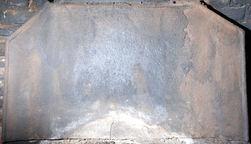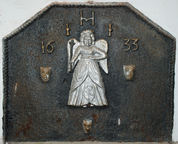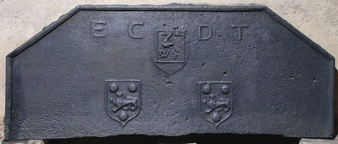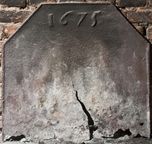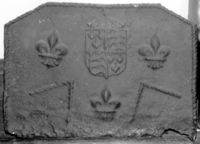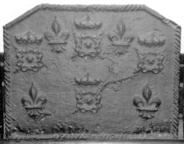-
1177
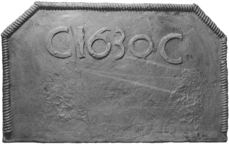 ? x ? mmImage subject to copyright
? x ? mmImage subject to copyrightDescription: Canted rectangular shape; twisted rope edging (top and sides); top centre, inscription 'C1630C'.
Notes: In the inscription, the letter 'C' may have been formed from a horseshoe. The fireback was discovered in 1959 at the works of Samuel Lewis & Co. Ltd. at Netherton, Worcestershire. It has been suggested that it was probably made by Walter Chetwynd, tenant of the ironworks at Cannockwood in Staffordshire who is mentioned as such in accounts of 1636 and 1637 made by Roger Jones received for William, Lord Paget of Beaudesert, the owner of the works.
Inscription: C1630C
- Decoration tags:
- rectangular with canted top corners (shape)
- rope (edging)
- simple stamps
- carved stamps
Manufactured: in 1630 possibly in the Cannock Chase area of England.
Current location: not known.
- Attached to series:
- Date & initials firebacks
-
55
Description: Canted rectangle; cavetto moulded edging (top and sides); single horizontal fillet below canted corners and vertical fillet parallel to each side, dividing the fireback into two side panels, two top corner panels, top panel and main central panel; ‘daisy’ plant stamp in top corners, and at outer end of top panel enclosing two, opposite facing, lion passant stamps with date between; swirling foliage stamp repeated in each side panel above initial, I to left, B to right; stamp of ‘Indian’ smoking a pipe in top left of central panel, stamp of seated ‘gentleman’ smoking a pipe and holding another, at top right.
Notes: The 'daisy' stamp and the IB initials are identical to those on similar firebacks dated between 1703 and 1721, and probably indicating the same founder. The use of stamps relating to tobacco smoking may suggest an origin near Bristol, the main entry port for the tobacco trade at that time. Lent to Dyrham Park by the late John Workman OBE, of Sheepscombe, Gloucs. in 1963, and given in 1996.
Inscription: 1708 / I B
- Decoration tags:
- rectangular with canted top corners (shape)
- cavetto (edging)
- carved stamps
- individual numbers
- heraldic
- text
- animals
- humans
- plants
Manufactured: in 1708 in the Forest of Dean area of England.
Current location: Dyrham Park, Dyrham, Gloucestershire, England.
Museum number: 453259 (part of the National Trust museum group)
- Attached to series:
- IB series
- Date & initials firebacks
-
871
Description: Canted rectanular shape, with stepped fillet edging (top and sides); upper centre, horizontal ?leather twist above an inverted ?leather twist 'V'; on each side, a shield-shaped stamp repeated twice, the upper one of each being angled so its side is parallel to the canted edging.
Notes: The design on the shield is not recognisably heraldic in form, and appears to incorporate a possible pictorial element although this is not clear; the inverted 'V' shape may have apotropaic significance.
Copies of this fireback are known.
- Decoration tags:
- rectangular with canted top corners (shape)
- stepped fillet (edging)
- simple stamps
- carved stamps
- apotropaic
- objects
Manufactured: in the late-16th century in England.
Current location: in private hands, East Grinstead, West Sussex, England.
Citation: Lloyd, N., 1925, 'Domestic Ironwork I', Architectural Review, 58, pp. 58-67.
- Attached to series:
- Miscellaneous stamp firebacks
-
1012
Description: Canted rectangle with twisted rope edging (top and sides); rope line separating rectangle from trapezoidal section, which is, in turn, separated by rope lines into a central rectangle containing a rebated lozenge stamp beneath the date (reversed), and two mirrored triangles each containing what appear to be mirrored stamps of a bird, possibly a partridge, and an initial; both the initials and the date are reversed.
Notes: Reversal of numerals and letters is not uncommon on firebacks.
Inscription: E [or] F 16 04 C
- Decoration tags:
- rectangular with canted top corners (shape)
- rope (edging)
- carved stamps
- individual numbers
- text
- animals
- objects
Manufactured: in 1604 possibly in the Weald area of England.
Current location: not known.
Citation: Eschbaecher, J., 22 Jan 1959, 'Why in reverse?' [letter], Country Life, p. 153.
- Attached to series:
- Miscellaneous stamp firebacks
- Date & initials firebacks
-
65
Description: Canted rectangle; twisted rope edging; plain plate
- Decoration tags:
- rectangular with canted top corners (shape)
- rope (edging)
- simple stamps
Manufactured: in the 16th or 17th century possibly in the Weald area of England.
Current location: in private hands, Fernhurst, West Sussex, England.
- Attached to series:
- Base boards
-
293
Description: Canted rectangle; inset twisted rope edging (top and sides); stamp formed of a statuette of an standing angel with left hand at the waist, and holding a sceptre in the right hand; date split either side of angel; initials in triad above angel; small face stamp repeated three times, one each side of angel, and one below.
Notes: The identity of those to whom the initials refer is not known; the use of the angel statuette is a rare inclusion of a religious motif on an English fireback. A variant of this fireback is at the Lygon Arms Hotel, Broadway, Worcestershire (no. 1027).
Inscription: IHI [triad] / 16 33
- Decoration tags:
- rectangular with canted top corners (shape)
- rope (edging)
- carved stamps
- individual letters
- individual numbers
- text
- humans
Manufactured: in 1633 in the Forest of Dean area of England.
Current location: Flaxley Abbey, Flaxley, Gloucestershire, England.
Citation: Bick, D. E. [incorrectly printed as Bick, R.], Sept 1985, 'Firebacks', Period Homes, pp. 21-4.
- Attached to series:
- Date & initials firebacks
- Figurine firebacks
- Angel series
-
68
Description: Canted rectangle; ovolo edging (top and sides); symmetrically arranged, initials separated by overpressed, fillet edged stamp bearing letters WF surmounted by a bent arm holding a battleaxe issuing from a chapeau; beneath are two shields bearing the arms of Fowle.
Notes: The shield and crest stamps relate to William Fowle (1568-1634) and are those used on iron grave slabs in Wadhurst and Frant churches and in Maidstone museum, as well as on other firebacks. The initials have not been identified. The fireback was formerly in Riverhall, Wadhurst, built by William Fowle. Another casting with the same set of initials, but in a slightly different arrangement, has been noted (no. 1077), and Christy (1908 p.386) reported on another with slots for two firedogs.
Inscription: EC DT / WF
Arms: William Fowle, of Frant and Wadhurst
- Decoration tags:
- rectangular with canted top corners (shape)
- astragal (edging)
- carved stamps
- individual letters
- heraldic
- armorial
- text
Manufactured: in the early- to mid-17th century probably at Riverhall Furnace, Wadhurst in the Weald area of England.
Current location: in private hands, Frant, East Sussex, England.
- Attached to series:
- Fowle series
-
1243
Description: Canted rectangular shape; twisted rope edging (top and sides); top centre, date '1675'.
Notes: Similar, in size, shape and position of numerals, to a fireback of 1670 but the numerals are from a different stock.
Inscription: 1675
- Decoration tags:
- rectangular with canted top corners (shape)
- rope (edging)
- carved stamps
- individual numbers
- text
Manufactured: in 1675 in England.
Current location: Harvington Hall, Chaddesley Corbett, Worcestershire, England.
(part of the Roman Catholic Archdiocese of Birmingham museum group)
- Attached to series:
- Date only firebacks
-
124
Description: Canted rectangle; twisted rope edging (top and sides); top centre, crowned Tudor royal shield; fleur de lys on each side and below; slanting, inverted 'V' of twisted rope on each side of lower fleur.
Notes: One of a large series of firebacks incorporating Tudor heraldic stamps; the 'V' shapes may have apotropaic significance.
Arms: Tudor royal arms of England
- Decoration tags:
- rectangular with canted top corners (shape)
- rope (edging)
- simple stamps
- carved stamps
- heraldic
- apotropaic
- armorial
- objects
Manufactured: in the mid-16th century in the Weald area of England.
Current location: Hastings Museum and Art Gallery, John's Place, Bohemia Road, Hastings, East Sussex, England.
Museum number: HASMG: 1904.32 (part of the Hastings Museum museum group)
- Attached to series:
- Royal series
-
128
Description: Canted rectangle; twisted rope edging (top and sides), with dowel across the top corners; symmetrical arrangement of four crowned four-petal roses, top centre, bottom centre and both top corners; symmetrical arrangement of four fleurs de lys, two either side of top central rose, two in bottom corners.
Notes: One of a large series bearing heraldic stamps. Given to Hastings Museum by Mr A. E. Anderson of Brightling Hall, Robertsbridge, Sussex.
- Decoration tags:
- rectangular with canted top corners (shape)
- rope (edging)
- carved stamps
- heraldic
Manufactured: in the mid-16th century in the Weald area of England.
Current location: Hastings Museum and Art Gallery, John's Place, Bohemia Road, Hastings, East Sussex, England.
Museum number: HASMG: 1914.64.1 (part of the Hastings Museum museum group)
Citation: Butterfield, W. R., 16 Feb 1935, 'A Tudor Fireback', Hastings and St Leonards Observer.
Citation: Baines, J. M., 1958, Wealden Firebacks (Hastings Museum).
- Attached to series:
- Royal series
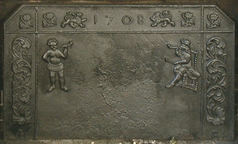
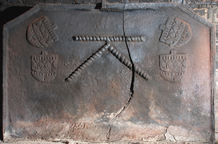
 762x533.jpg)
